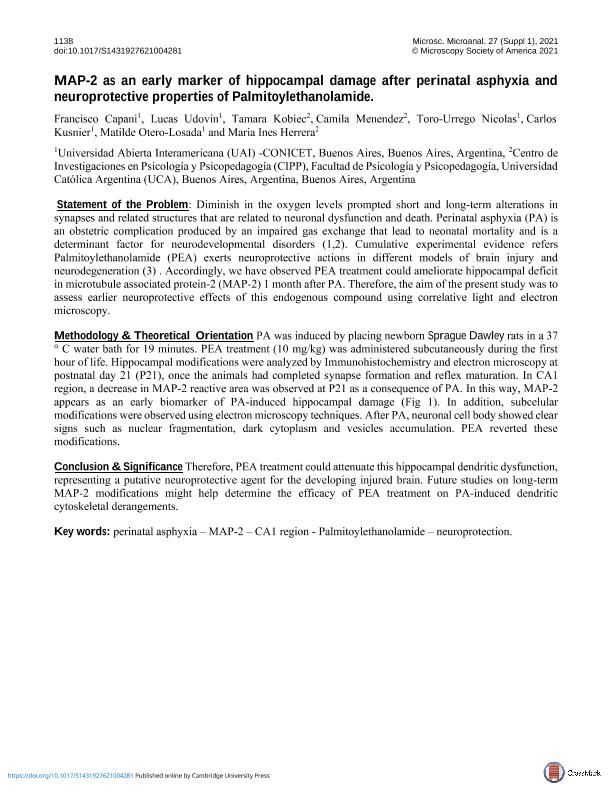Mostrar el registro sencillo del ítem
dc.contributor.author
Capani, Francisco

dc.contributor.author
Udovin, Lucas

dc.contributor.author
Kobiec, Tamara

dc.contributor.author
Menéndez Maissonave, Camila Belen

dc.contributor.author
Toro Urrego, Nicolas

dc.contributor.author
Kusnier, Carlos Federico

dc.contributor.author
Otero-losada, Matilde Estela

dc.contributor.author
Herrera, María Inés

dc.date.available
2022-08-18T13:02:43Z
dc.date.issued
2021-06
dc.identifier.citation
Capani, Francisco; Udovin, Lucas; Kobiec, Tamara; Menéndez Maissonave, Camila Belen; Toro Urrego, Nicolas; et al.; MAP-2 as an early marker of hippocampal damage after perinatal asphyxia and neuroprotective properties of Palmitoylethanolamide; Cambridge University Press; Microscopy & Microanalysis; 27; 1; 6-2021; 1-2
dc.identifier.issn
1431-9276
dc.identifier.uri
http://hdl.handle.net/11336/165963
dc.description.abstract
Statement of the Problem: Diminish in the oxygen levels prompted short and long-term alterations insynapses and related structures that are related to neuronal dysfunction and death. Perinatal asphyxia (PA) isan obstetric complication produced by an impaired gas exchange that lead to neonatal mortality and is adeterminant factor for neurodevelopmental disorders (1,2). Cumulative experimental evidence refersPalmitoylethanolamide (PEA) exerts neuroprotective actions in different models of brain injury andneurodegeneration (3) . Accordingly, we have observed PEA treatment could ameliorate hippocampal deficitin microtubule associated protein-2 (MAP-2) 1 month after PA. Therefore, the aim of the present study was toassess earlier neuroprotective effects of this endogenous compound using correlative light and electronmicroscopy.Methodology & Theoretical Orientation PA was induced by placing newborn Sprague Dawley rats in a 37° C water bath for 19 minutes. PEA treatment (10 mg/kg) was administered subcutaneously during the firsthour of life. Hippocampal modifications were analyzed by Immunohistochemistry and electron microscopy atpostnatal day 21 (P21), once the animals had completed synapse formation and reflex maturation. In CA1region, a decrease in MAP-2 reactive area was observed at P21 as a consequence of PA. In this way, MAP-2appears as an early biomarker of PA-induced hippocampal damage (Fig 1). In addition, subcelularmodifications were observed using electron microscopy techniques. After PA, neuronal cell body showed clearsigns such as nuclear fragmentation, dark cytoplasm and vesicles accumulation. PEA reverted thesemodifications.Conclusion & Significance Therefore, PEA treatment could attenuate this hippocampal dendritic dysfunction,representing a putative neuroprotective agent for the developing injured brain. Future studies on long-termMAP-2 modifications might help determine the efficacy of PEA treatment on PA-induced dendriticcytoskeletal derangements.
dc.format
application/pdf
dc.language.iso
eng
dc.publisher
Cambridge University Press

dc.rights
info:eu-repo/semantics/openAccess
dc.rights.uri
https://creativecommons.org/licenses/by-nc-sa/2.5/ar/
dc.subject
PERINATAL ASPHYXIA
dc.subject
MAP-2
dc.subject
CA1 REGION
dc.subject
PALMITOYLETHANOLAMIDE
dc.subject
NEUROPROTECTION
dc.subject.classification
Neurociencias

dc.subject.classification
Medicina Básica

dc.subject.classification
CIENCIAS MÉDICAS Y DE LA SALUD

dc.title
MAP-2 as an early marker of hippocampal damage after perinatal asphyxia and neuroprotective properties of Palmitoylethanolamide
dc.type
info:eu-repo/semantics/article
dc.type
info:ar-repo/semantics/artículo
dc.type
info:eu-repo/semantics/publishedVersion
dc.date.updated
2022-08-16T12:03:01Z
dc.journal.volume
27
dc.journal.number
1
dc.journal.pagination
1-2
dc.journal.pais
Reino Unido

dc.journal.ciudad
Cambridge
dc.description.fil
Fil: Capani, Francisco. Universidad Abierta Interamericana; Argentina. Consejo Nacional de Investigaciones Científicas y Técnicas; Argentina
dc.description.fil
Fil: Udovin, Lucas. Universidad Abierta Interamericana; Argentina. Consejo Nacional de Investigaciones Científicas y Técnicas; Argentina
dc.description.fil
Fil: Kobiec, Tamara. Pontificia Universidad Católica Argentina "Santa María de los Buenos Aires". Facultad de Psicología y Psicopedagogía. Centro de Investigaciones en Psicología y Psicopedagogía; Argentina. Consejo Nacional de Investigaciones Científicas y Técnicas; Argentina
dc.description.fil
Fil: Menéndez Maissonave, Camila Belen. Pontificia Universidad Católica Argentina "Santa María de los Buenos Aires". Facultad de Psicología y Psicopedagogía. Centro de Investigaciones en Psicología y Psicopedagogía; Argentina
dc.description.fil
Fil: Toro Urrego, Nicolas. Universidad Abierta Interamericana; Argentina. Consejo Nacional de Investigaciones Científicas y Técnicas; Argentina
dc.description.fil
Fil: Kusnier, Carlos Federico. Universidad Abierta Interamericana; Argentina. Consejo Nacional de Investigaciones Científicas y Técnicas; Argentina
dc.description.fil
Fil: Otero-losada, Matilde Estela. Universidad Abierta Interamericana; Argentina. Consejo Nacional de Investigaciones Científicas y Técnicas; Argentina
dc.description.fil
Fil: Herrera, María Inés. Pontificia Universidad Católica Argentina "Santa María de los Buenos Aires". Facultad de Psicología y Psicopedagogía. Centro de Investigaciones en Psicología y Psicopedagogía; Argentina
dc.journal.title
Microscopy & Microanalysis

dc.relation.alternativeid
info:eu-repo/semantics/altIdentifier/url/https://www.cambridge.org/core/services/aop-cambridge-core/content/view/8CB14D6F752A2C8E14B6FEA844C459FC/S1431927621004281a.pdf/map-2-as-an-early-marker-of-hippocampal-damage-after-perinatal-asphyxia-and-neuroprotective-properties-of-palmitoylethanolamide
dc.relation.alternativeid
info:eu-repo/semantics/altIdentifier/doi/http://dx.doi.org/10.1017/S1431927621004281
Archivos asociados
